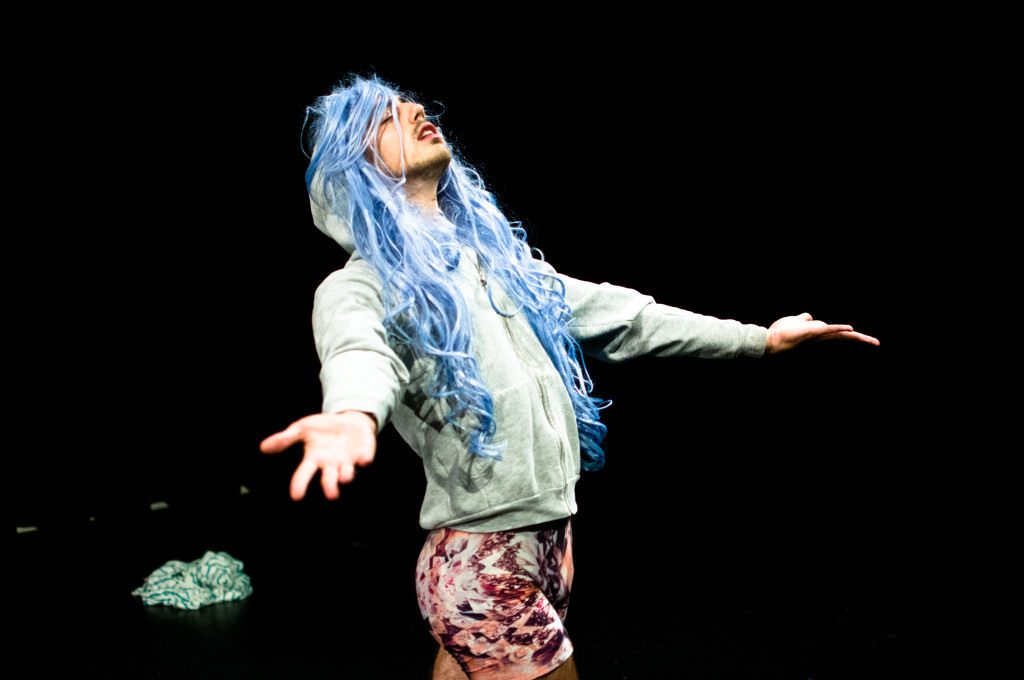James Gardella’s “rise and heart (invocation)” at Dixon Place Theater
Author | Sophie Sotsky
Photography by Andy Ribner
James Gardella’s “rise and heart (invocation)” is as intimate as it is performative.
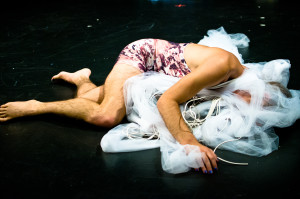 In this solo dance work about desire, Gardella expertly navigates between internal and external modes of being; I had the sense that the scene unfolding before me was taking place simultaneously in two spaces: a public and a private one.
In this solo dance work about desire, Gardella expertly navigates between internal and external modes of being; I had the sense that the scene unfolding before me was taking place simultaneously in two spaces: a public and a private one.
This is a common sensation when viewing queer work.
Queer people have historically and continue to experience a troubling gamut of legislation encroaching upon their personal lives and attempting to expand or limit their freedoms: some policies have inserted the law into the private sphere of domestic life while others have exiled public queer sexual identity to secrecy.
This work celebrates the traversal between the internal and the external, both distinguishing and melding the two.
 “rise and heart…” touches on the myriad themes of drag, gender, sexuality, ritual, spirituality and artistic persona. At times this work accosts us with bombastic, celebratory flamboyance. At times it holds us at an arms length. In some moments I felt as if I were outside peering in through a window at someone praying inside their own home.
“rise and heart…” touches on the myriad themes of drag, gender, sexuality, ritual, spirituality and artistic persona. At times this work accosts us with bombastic, celebratory flamboyance. At times it holds us at an arms length. In some moments I felt as if I were outside peering in through a window at someone praying inside their own home.
The piece began with Gardella shrouded in an enormous headdress. His face was completely obscured by a mass of spray painted foam. Tulle cascaded down around him like a curtain.
He moved tentatively around the stage, the weight of this great caul causing his head to tip, bob and sway. He was a ghostly gliding Miyazaki-esque bobble-head.
A deconstruction of drag, perhaps. Or at least, an abstraction of it. My attention was drawn to the inflation of the head, a hyper-ego; and to the luxury of fabric and femininity, an indulgent facade.
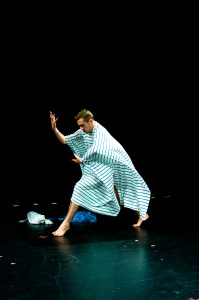 Moments later, headdress discarded and face revealed, Gardella paced fastidious circles around the space, arms out wide, bent slightly at the elbow, and fingers sparked up like the branches of a tree. A ritual. He might have been summoning a spirit from another world.
Moments later, headdress discarded and face revealed, Gardella paced fastidious circles around the space, arms out wide, bent slightly at the elbow, and fingers sparked up like the branches of a tree. A ritual. He might have been summoning a spirit from another world.
In these moments — worship-like— Gardella’s extensive training in yoga is apparent. His slow and controlled movement style is yogic. So too is his presence.
Gardella made all of the costumes for this work, and also makes clothing outside of his dance practice.
Dance costumer Reid Bartelme once wrote, “Costumes are a way of bringing choreography into focus.”1 But Gardella’s two-headed work reminds me that costuming is also a choreography in its own right.
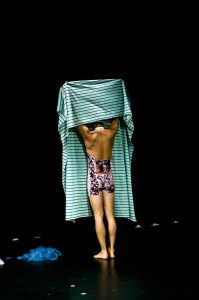 Over the course of the piece, Gardella changed his costumes – and with them, his personas – numerous times. His character was constantly in flux, never settling on one state to call home. He lay tangled in tulle on the floor; he paced ritualistically in a shapeless Moses tunic. He lobbed limp fists into the pockets of a sweatshirt, shrugging; then pranced about in a pink, skin-tight halter-top leotard-romper. From a giant balloon-headed headdress to bizarre, pink, over-sized sunglasses made from CDs, spray paint, and ribbon, Gardella changed fluidly from one shell to the next. Each new look constituted an extension of the self, a frame to bring the choreography into focus, and a new development in the independent narrative arc of costuming.
Over the course of the piece, Gardella changed his costumes – and with them, his personas – numerous times. His character was constantly in flux, never settling on one state to call home. He lay tangled in tulle on the floor; he paced ritualistically in a shapeless Moses tunic. He lobbed limp fists into the pockets of a sweatshirt, shrugging; then pranced about in a pink, skin-tight halter-top leotard-romper. From a giant balloon-headed headdress to bizarre, pink, over-sized sunglasses made from CDs, spray paint, and ribbon, Gardella changed fluidly from one shell to the next. Each new look constituted an extension of the self, a frame to bring the choreography into focus, and a new development in the independent narrative arc of costuming.
Among Gardella’s guises were two pastel wigs, summoning the specter of classical drag.
 The “drag” of it, though, felt incidental. The cross-dressing, so to speak, was just one matter-of-fact element in an overarching experimental-dance-ified game of dress up. The kind of dress-up game we all play in our own rooms: when you’re about to go out for the night, you’re drinking a beer, standing in front of your mirror, singing out-loud to that new gorilla vs bear mix, trying on that ridiculously flashy sequin top and thinking, I could be this person tonight.
The “drag” of it, though, felt incidental. The cross-dressing, so to speak, was just one matter-of-fact element in an overarching experimental-dance-ified game of dress up. The kind of dress-up game we all play in our own rooms: when you’re about to go out for the night, you’re drinking a beer, standing in front of your mirror, singing out-loud to that new gorilla vs bear mix, trying on that ridiculously flashy sequin top and thinking, I could be this person tonight.
All gender is drag, I am reminded. (#Hash #Tag #Judith #Butler!)
In the era of post-RuPaul-drag, “alternative drag” has become the dominant paradigm in the queer new world of Brooklyn nightlife. Here in venues such as Don Pedro, Metropolitan and Bizarre, “performance art” tropes are seeping into drag. Smartly, James was able to do the reverse here: he sprinkled alternative drag tropes effortlessly into a piece of experimental dance by way of incidental reference.
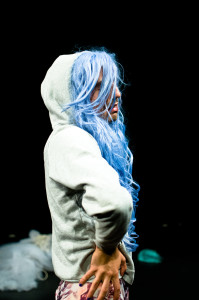 This piece is not about drag, and yet its understated, thematic presence speaks powerfully to its universality.
This piece is not about drag, and yet its understated, thematic presence speaks powerfully to its universality.
Though its use of drag is incidental, “rise and heart” does boldly address issues of gender performativity. Gardella is developing a performance persona, one more outlandish than his everyday persona — necessarily. In regards to his stage persona, Gardella said he feels as if he is “living out a fantasy to reconcile who I am with who I want to be, or ‘perform’ myself as.” This element of his work isn’t meant to be political as much as it is simply the authentic manifestation of thoughtful self-examination. Yet, what he captures and powerfully communicates feels both emotionally salient and indeed political: more often than not, our experiences of gender vastly pale in comparison to our performances of gender— or the fantastical genders we might like to perform.
Towards the end of the piece, electronic music played and Gardella danced defiantly, wearing outlandish sunglasses, exuding flamboyance, sporting confidence – and almost a “screw-you” attitude. This was the dance-like-no one’s watching moment. The how-I-really-dance-when-I’m-alone-in-my-room moment.
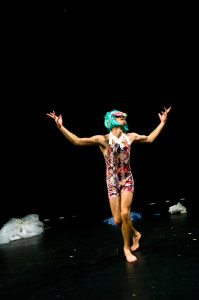 If the quiet moments – Gardella lying on the floor enmeshed in fabric, Gardella facing away in private prayer – felt intimate, personal, so too did this energetic bout at the end.
If the quiet moments – Gardella lying on the floor enmeshed in fabric, Gardella facing away in private prayer – felt intimate, personal, so too did this energetic bout at the end.
Gardella told me that this work derived from an older piece: a dance in which he said, “my goal was to let my heart rise to bring me to stand, then explode my heart all over the stage.” In the closing moments of the piece we could all feel that energy radiating.
If I did not originally understand the connection between these two worlds — the yogic world of prayer, ritual and internal sensation and the flamboyant world of sexuality, drag and external presentation — they came together triumphantly in this moment of radiating energy from the heart.
On July 19th, James performed in conjunction with KineticArchitecture in the 23rd Annual HOT! Festival at Dixon Place theater. The HOT! Festival celebrates Queer Culture in NYC, presenting work across numerous performance disciplines from puppetry to poetry. It is “the world’s longest-running LGBTQ Performance Festival,” says Dixon Place. The HOT! Festival runs through August 2nd.
1Movement Research: Performance Journal #43

